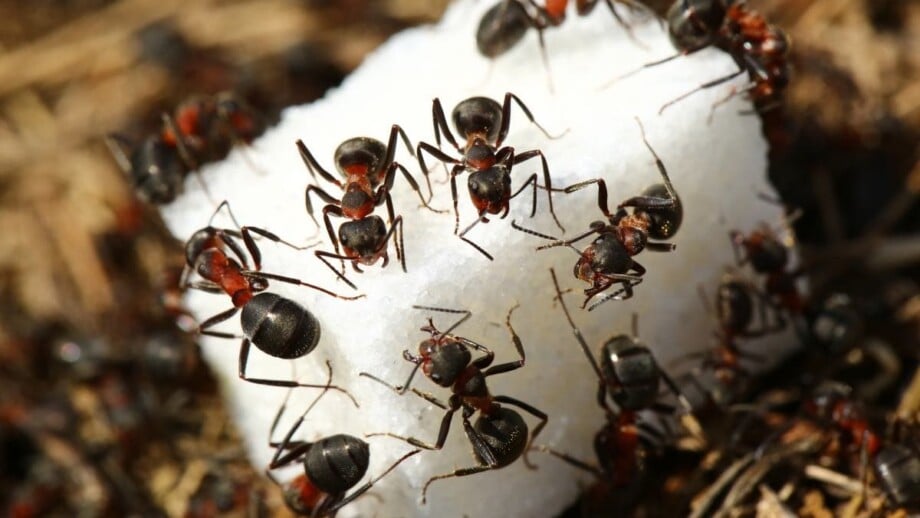As their name suggests, sugar ants have a particular affinity for sweet substances, and their organized foraging behavior and social structure make them a fascinating species to observe.
Sugar ant is a term used to describe many ant species that all share their love of sugar. Sugar ants enter your home in search of sweet and sugary food. They eat baked goods, fruits, raw sugar, sweets, and honeydew from aphids.
Little black ants, pavement ants, carpenter ants, and ghost ants are some of the insects that fall into the sugar ant category.
How Can You Spot Sugar Ants?
Since there are several types of sugar ants, they vary in size and color. But they range from 1-13 mm and can have brown, reddish-brown, black, white, or even yellow bodies. They tend to have a tiny waist, large blackheads, and a rusty brownish middle. Sugar ants are often spotted in kitchens (especially on kitchen counters), sinks, cabinets, and sometimes outdoors under rocks and logs.
Types of Sugar Ants
There are over a hundred different species of ants worldwide, with a small portion feeding on sugary foods. The term sugar ant in America is a colloquial term used to identify several species of ants that are attracted to and feed on sweet food. However, the real sugar ant (better known as the banded sugar ant) is native to Australia and is not found in the United States.
The following list can help you identify some of the most common sugar ant species in the U.S. Once you identify the type of sugar ants in or outside your home, you can determine what kind of damage it causes and where it is likely to nest.
Carpenter Ants
Carpenter ants are generally black, brown, red, or a combination of red and black. They are large, and they measure around 0.25 to 0.75 inches long.
Carpenter ants are omnivorous pests feeding on aphids’ honeydew, indoor sweet-like products like honey, meats, and pet food. Though these ants are avid eaters, they do not feed on wood.
Carpenter ant colonies are active all year round in warmer climates, typically separating into two colony sites: parent nest (workers, eggs, and queen) and satellite nest (larvae, pupae, and workers).
The parent nest is usually within woody areas containing moisture, like trees, fences, windows, firewood, door frames, and other wooden structures.
Satellite nests can be found both indoors and outdoors around dry areas such as wall voids, insulation, and decaying wooden surfaces. Usually, these nests are close to each other as workers must carry the larvae to mature in these sites.
The worker ants come out during the evening and create tunnels through moist or hollow wood.
Depending on the size of the nests and pests, carpenter ants can cause structural damage to your home if left untreated.

Pavement Ants
These tiny ants measure around ⅛ inches long, and their color can range from black to brown. Their legs are lighter than their bodies, and they usually have grooves on their head and thorax.
They are considered pests as they leave trails to food sources like seeds, dead insects, fruits, greasy foods, cheese, bread, meats, and honeydew from aphids.
Pavement ants are territorial and will protect their colonies if they feel threatened. They create their nests in different areas, such as crevices and crack in pavement, sidewalk, curbs, and driveways. Pavement ants nests can also be found beneath logs, rocks, and yard debris, along the house foundation, and indoors underneath carpets and near wall voids.
When searching for indoor foods, these ants spread very easily and quickly, making them a nuisance for homeowners. Nests can be hard to locate since they can hide in the tiniest crevices. For this reason, using ant baits, treating cracks and crevices with dust, and direct control with outdoor perimeter applications will help eliminate them.

Rover Ants
Rover ants are known for being less aggressive than most ant species. In fact, they usually avoid biting and lack a stinger. This type of ant is reddish-brown and is very small, measuring 1 to 3 mm. Unlike other ants, the rover can easily be identified by its 9-segmented antennae, whereas other ant species have 12 segments.
This type of ant feeds mainly on sugars such as honeydew made by scales or aphids, plant nectar, and tree sap but can switch to protein-based foods like insects during summer and fall.
Rover ants typically favor the outdoors for their nest, especially in soil, loose tree bark, and rotting tree trunks.
If they’re located indoors, they usually invade potted plants and other areas where moisture collects, like crevices and cracks, attics, basements, and near water heaters.
Though these ants won’t bite or sting, they can become irritating with their significant populations and foraging activities.

Little Black Ants
As their name suggests, little black ants are tiny (around 1/16 inch long) and jet-black or dark brown ants.
While these ants have a stinger, they’re too small and weak to use it.
Little black ants feed on extracted honeydew from aphids and scales, sweets, fruits, meat, oil, grease, insects, and products made from vegetables like corn.
These ants mainly nest outdoors in open lawns, decaying woods, and sidewalk cracks. They may also nest indoors within wall voids, rotten wood surfaces, cabinets, and woodwork.
Though they don’t create immediate damage, little black ants can become a nuisance with their large populations to homeowners.

Acrobat Ants
Crematogaster Ashmeadi (Emery), also known as Acrobat Ants, can measure up to 3.2 mm in length and feed on live and dead insects, but they also eat honeydew made by mealybugs, aphids, and other home sweets and protein.
Acrobat ants can be light red, brown, or black, with a big, heart-shaped abdomen. When these ants feel threatened, they raise their abdomen in defense, earning them their name.
Acrobat ants create their nests outdoors in rotting, damp wood and shaded areas. They can also be found on trees, wood piles, shrubs, water meter boxes, and homes’ foundations. However, this type of ant can create nests indoors near bathrooms, electrical wiring, attics, kitchens, and water supply areas at home.
Odorous House Ants
These are small brown/black ants that can grow up to ⅛ of an inch.
When crushed, odorous house ants have earned their reputation by releasing a foul coconut odor.
These ants prefer foods high in sugar, like cake, candy, cookies, jams, or other sweet foods. When they nest outdoors, these ants feed on aphids’ honeydew.
Odorous house ants live comfortably outdoors underneath yard debris and clutter, but they can be found inside near humid sites like kitchens under appliances and under sinks.
From spring to summer, odorous house ants establish trails for finding reliable food sources; If not treated, more nests will appear.

Pharaoh Ants
Pharaoh ants can measure up to 1 inch and tend to be yellow to light reddish-brown.
Pharaoh ants can be identified by their dark-colored abdomen, similar to odorous house ants. This type of ant can release a strong smell and have a urine-like smell when crushed.
Pharaoh ants are opportunistic feeders consuming various food and liquids such as syrup, fruit, soda, meat, and dead insects in swarms.
Pharaoh ants nest almost anywhere with moist and warm conditions, like crevices, cracks, sinks, electrical outlets, wall voids, floors, and ceilings. When these ants nest outdoors, they can be found underneath flat stone surfaces like bricks, rocks, logs, woodpiles, near pavements, and in shaded areas. But, most of the time, these ants can be found indoors, traveling through electrical outlets and plumbing.

Argentine Ants
Argentine ants can measure ⅛ of an inch up to 3.5 mm in length, and they are light to dark brown.
Unlike other types of ants, Argentine ants don’t have stingers and are known to protect themselves and their colonies with several bites if provoked.
During warm seasons, nests are located in soil and tend to be very shallow.
Though these ants do not nest indoors, they are mostly found in moist but not wet areas like electrical fixtures, indoor pipes, or sinks.
Besides being a household pest, this ant can destroy outdoor vegetation by feeding on aphids’ honeydew.

What Causes Sugar Ants in your Home?
Although they are called sugar ants, they eat various foods depending on their appetite.
Ants generally look for easy access to food, cozy living conditions, and water. Before these insects raid your trashcan, food, or outdoors, ants first need access to your home.
Ants are very small, numerous, and resourceful. They often come right through the window, doors, or small gap. But they can also enter your home through vents, traveling along pipes, wires, or subflooring beneath wood, carpet, or tiled floors.
There may be several reasons sugar ants pop into your home. These could include:
- An attractant (food, water, or comfy living source)
- Warm weather arrival like spring or summer
- A nearby nest (indoor or outdoors)
- Garden watering or recent rainy weather
How to Get Rid of Sugar Ants
If sugar ants have suddenly popped up in your house, you can immediately remove the ant-covered object from your home, be patient and wait a day to see what the activity does. If this doesn’t help, you can use ant baits to draw ants from high-traffic areas and observe whether their activity dies down.
You can also mix up a 3:1 white vinegar and water mixture in a spray bottle and thoroughly soak all visible ants.
Vinegar kills ants and removes the scent trail that attracts them.
Besides the previous quick-fix tips, you can try any of these tips:
- Make sure crevices and cracks around your home area are sealed, especially in places where you’ve seen ants trailing
- Reduce possible food sources like sweet food crumbs
- Fix any leaking pipes and ensure your sink is working properly to minimize moisture
- Treat soil with insecticide
- During winter, have a local pest control company treat for aphids; this way, you can reduce springtime honeydew.
Other Ant Guides from Planet Natural:











